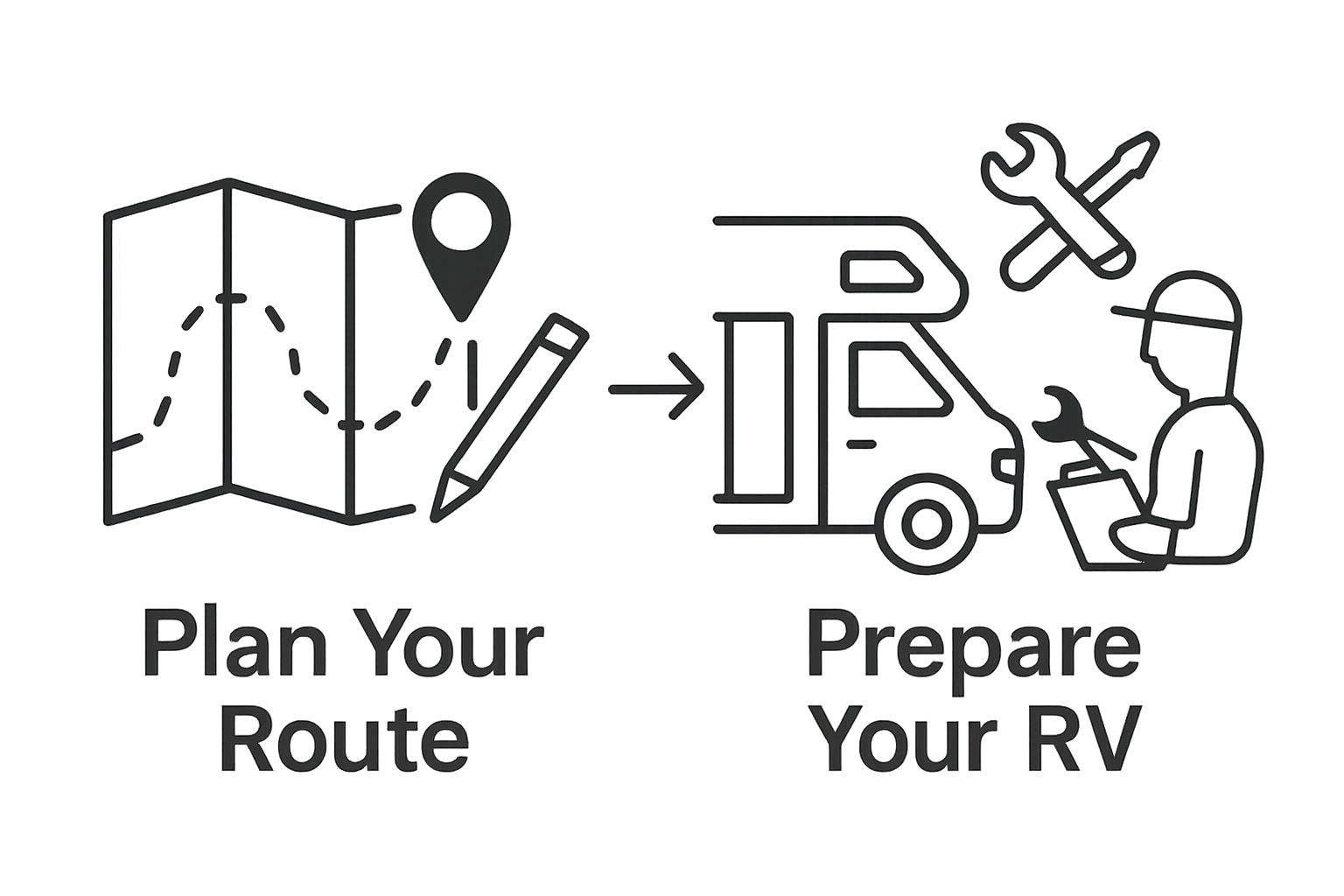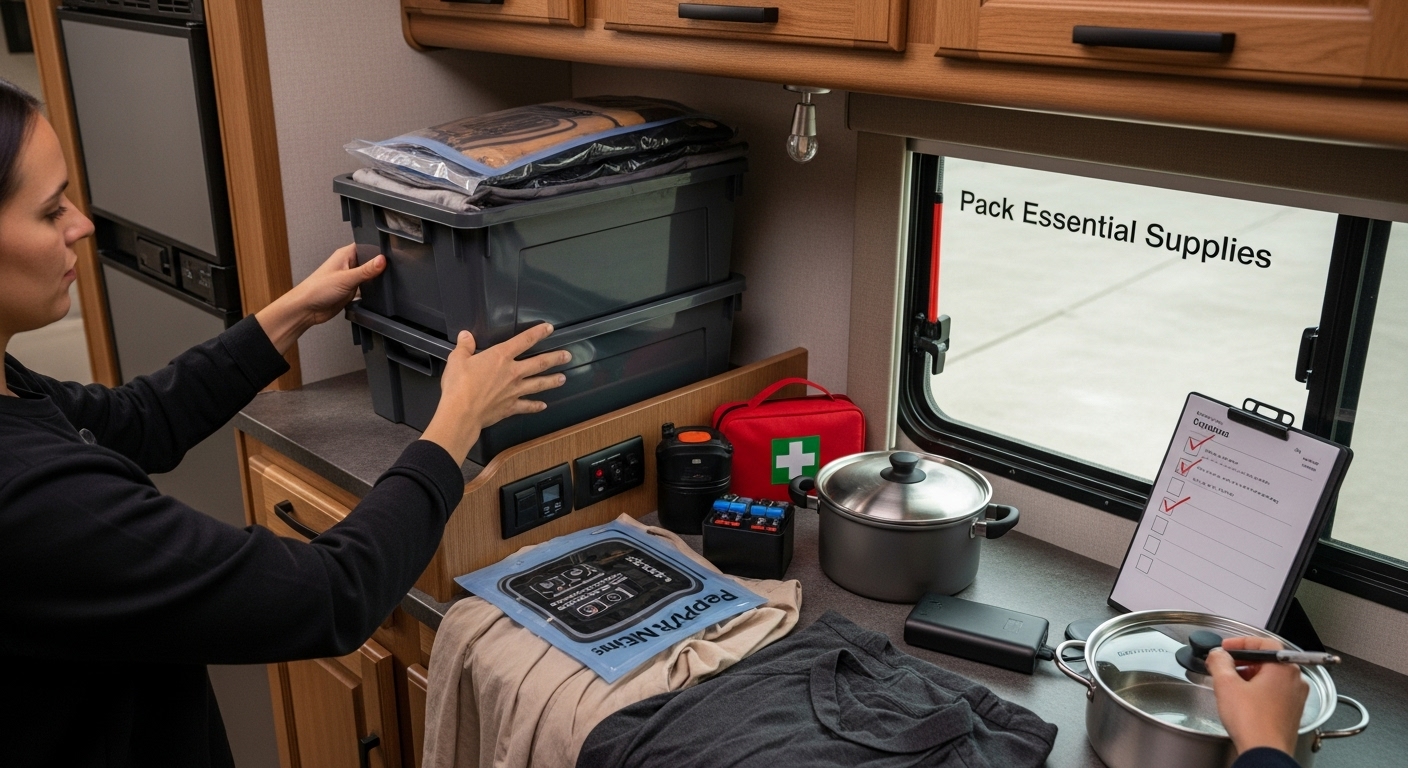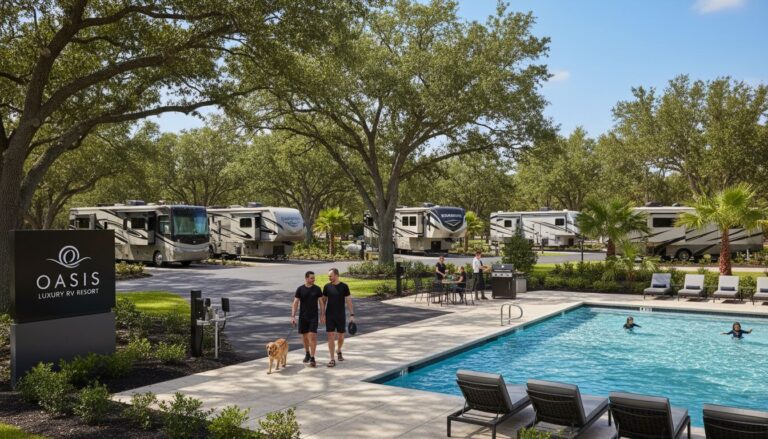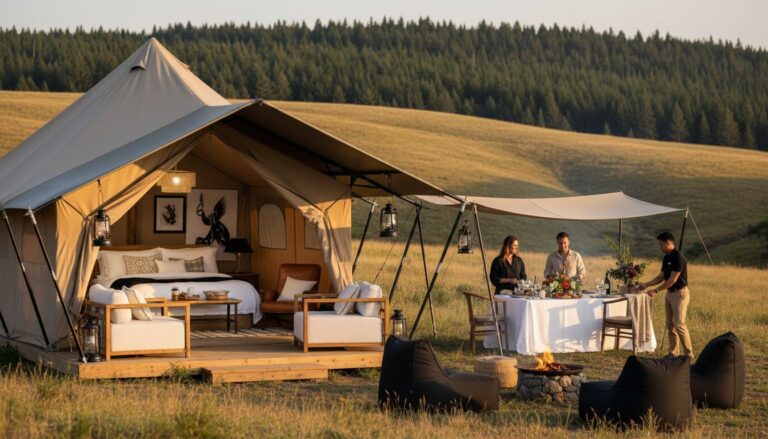Planning an extended RV trip sounds like the dream—imagine cruising wherever you want with your home right behind you. Most people think it is just a matter of packing bags and driving off into the sunset. But the difference between a stressful odyssey and a smooth adventure often comes down to smart planning and surprising details, like how proactive system checks can prevent 80 percent of potential roadside breakdowns. Most RV travelers have no idea how much peace of mind starts with knowing what to prep long before you ever put the RV in gear.
Table of Contents
- Step 1: Plan Your Route And Destinations
- Step 2: Prepare Your RV For Long-Term Travel
- Step 3: Pack Essential Supplies And Gear
- Step 4: Organize RV Living Essentials
- Step 5: Verify Safety And Maintenance Checks
- Step 6: Finalize Itineraries And Reservations
Quick Summary
| Key Point | Explanation |
|---|---|
| 1. Plan Your Route Thoroughly | Create a detailed travel strategy considering weather, road conditions, and RV-friendly paths for a safer journey. |
| 2. Complete RV Maintenance Checks | Conduct a comprehensive inspection of essential systems like brakes and tires to ensure your RV is travel-ready. |
| 3. Optimize Packing for Space | Categorize and strategically pack supplies to maximize space while ensuring access to essential items during travel. |
| 4. Organize Living Essentials Efficiently | Use strategic storage solutions to create functional living spaces that enhance comfort and accessibility in your RV. |
| 5. Finalize Reservations and Itineraries | Plan and confirm campgrounds and routes in advance, allowing for flexible travel while ensuring accommodations are secure. |
Step 1: Plan Your Route and Destinations
Planning your route and destinations represents the critical foundation of any successful extended RV trip. This initial phase transforms your journey from a potential logistical nightmare into a smooth, enjoyable adventure. Smart route planning goes far beyond simply plugging destinations into a GPS and hoping for the best.
Start by creating a comprehensive travel strategy that considers multiple factors beyond basic distance. Research your potential routes thoroughly, examining road conditions, potential construction zones, and RV friendly paths. Mapping applications designed specifically for RV travelers can provide invaluable insights into road width, height restrictions, and potential challenges unique to larger vehicles.
Consider the seasonal variations and weather patterns along your proposed route. Some regions experience significant climate changes that could impact travel comfort and safety. For instance, mountain passes might become challenging during winter months, while desert regions can pose extreme heat risks during summer. According to National Park Service Trip Planning Guide, understanding environmental conditions is crucial for safe travel.
Develop a flexible itinerary that allows room for unexpected discoveries and potential route modifications. While having a structured plan provides security, maintaining adaptability ensures you can take advantage of spontaneous opportunities. Identify potential stopping points, campgrounds, and RV parks along your route. Look for locations that offer:
- Full hookup facilities
- Convenient access to local attractions
- Reasonable proximity to emergency services
- Good cellular and internet connectivity
Utilize digital tools and apps specifically designed for RV travelers to streamline your planning process. Resources like RV trip planning websites can help you calculate precise travel times, estimate fuel costs, and locate suitable overnight accommodations. Remember that thorough preparation doesn’t mean eliminating spontaneity it means creating a framework that allows for exciting, unexpected experiences while maintaining overall trip safety and comfort.
Finally, share your detailed route plan with a trusted friend or family member. This provides an additional layer of safety and ensures someone knows your general whereabouts throughout your extended journey. A well-planned route is your roadmap to an unforgettable RV adventure.

Step 2: Prepare Your RV for Long-Term Travel
Preparing your RV for an extended journey is more than a simple checklist it is a comprehensive strategy to ensure your home on wheels remains safe, comfortable, and fully functional throughout your adventure. This critical step transforms your RV from a mere vehicle into a reliable traveling companion capable of handling the unpredictable challenges of long-term travel.
Mechanical readiness becomes your top priority during this preparation phase. Schedule a comprehensive professional inspection that goes beyond standard maintenance. This detailed assessment should include a thorough examination of your RV’s engine, transmission, brakes, tires, and electrical systems. Pay special attention to components that endure significant stress during extended travels, such as wheel bearings, suspension systems, and fluid levels.
Your interior preparation demands equal diligence. Conduct a meticulous inventory of your living space, ensuring all systems function optimally. Check refrigeration units, air conditioning, heating systems, and water infrastructure for potential issues. According to RV Safety and Maintenance Guidelines, proactive system checks can prevent 80% of potential roadside breakdowns.
Storage optimization represents another crucial aspect of RV preparation. Strategically organize your interior space to maximize efficiency and minimize potential damage during travel. Invest in secure storage solutions that prevent items from shifting during movement. Use non-slip mats, adjustable storage containers, and strategic packing techniques to maintain order and protect your belongings.
Consider your power and connectivity needs carefully. Verify that your battery systems, solar panels, and generator are fully functional and capable of supporting extended off-grid living. Test all electrical connections, including shore power adapters and internal wiring. Carry backup power solutions and understand their operational parameters.
Documentation preparedness cannot be overlooked. Compile a comprehensive travel folder containing:
- Detailed vehicle registration
- Current insurance documents
- Maintenance records
- Emergency contact information
- Roadside assistance details
Final preparation involves a comprehensive systems test. Conduct a full walkthrough of your RV, simulating travel conditions. Run all systems, check all connections, and verify that everything functions as expected. This final verification provides peace of mind and identifies potential issues before they become significant problems during your journey.
Remember, thorough preparation is the difference between a stressful travel experience and an incredible adventure. Your RV is more than a vehicle it is your temporary home, and treating it with careful, methodical preparation ensures a smooth, enjoyable extended trip.
Step 3: Pack Essential Supplies and Gear
Packing for an extended RV trip requires a strategic approach that balances practicality with comprehensive preparedness. This step transforms your RV from a basic vehicle into a fully equipped mobile living space capable of handling diverse challenges and unexpected situations.
Weight distribution and space management become critical considerations when selecting and packing your supplies. Begin by categorizing your gear into essential groups: survival equipment, daily living necessities, comfort items, and emergency supplies. This systematic approach prevents overpacking while ensuring you have everything needed for a comfortable and safe journey.
Critical survival and emergency gear should occupy a prominent place in your packing strategy. According to America’s State Parks Camping Checklist, your emergency kit should include multi-tools, first aid supplies, solar chargers, emergency blankets, and reliable communication devices. Strategically pack these items in easily accessible locations, ensuring quick retrieval during unexpected situations.
Your clothing selections require careful consideration. Choose versatile, layerable clothing that can adapt to changing weather conditions. Prioritize moisture-wicking fabrics, quick-drying materials, and items that can be mixed and matched. Pack clothing that serves multiple purposes to maximize limited storage space. Consider compression bags or vacuum-sealed storage solutions to minimize the volume of clothing and textiles.
Kitchen and cooking supplies demand thoughtful organization. Select lightweight, multi-functional cooking tools that can serve various culinary needs. Invest in compact, stackable cookware and collapsible kitchen accessories that save precious storage space. Consider portable cooking solutions like compact camping stoves, which provide flexibility for indoor and outdoor meal preparation.
Electrical and technological preparedness is equally important. Pack multiple charging solutions, including:
- Portable battery banks
- Solar charging panels
- Universal adapters
- Backup power strips
- Extra charging cables
Personal comfort items should not be overlooked. Include compact entertainment options like e-readers, tablets, or portable game systems. Pack compact, multi-purpose bedding that provides warmth and comfort without consuming excessive storage space. Consider lightweight, quick-drying towels and versatile blankets that can serve multiple functions.
Finalize your packing by conducting a comprehensive inventory check. Weigh your packed RV to ensure you remain within safe weight limits. Organize items strategically, placing heavier objects low and towards the center of the vehicle to maintain proper balance and stability during travel. Your meticulous preparation transforms potential travel challenges into manageable, even enjoyable experiences.
The following table organizes core categories of essential RV trip supplies with examples and space-saving tips, helping you pack efficiently for comfort and safety on your journey.
| Category | Examples | Space-Saving Tip |
|---|---|---|
| Survival/Emergency Gear | Multi-tool, first aid kit, solar charger, blankets | Place in easily accessible kits |
| Clothing | Layerable shirts, quick-dry pants, compression bags | Use vacuum/compression bags |
| Cooking Supplies | Nesting cookware, collapsible bowls, portable stove | Stack, choose multifunctional |
| Electronics | Battery banks, charging cables, solar panels | Use cable organizers |
| Personal Comfort | E-reader, compact bedding, quick-dry towels | Select multi-purpose items |

Step 4: Organize RV Living Essentials
Organizing your RV living essentials transforms a cramped mobile space into an efficient, comfortable home away from home. This critical step goes beyond simple storage it involves creating a functional living environment that maximizes every square inch of available space while maintaining comfort and accessibility.
Storage solutions become your most strategic asset when optimizing RV living spaces. Invest in modular, multi-functional storage containers that can be securely fastened and easily reconfigured. Look for lightweight, stackable options that can adapt to your changing needs while preventing items from shifting during travel. Utilize vertical space by installing adjustable shelving systems and hanging organizers that maximize storage potential without adding significant weight.
According to America’s State Parks Camping Checklist, strategic organization of personal items and living essentials can dramatically improve your travel experience. Implement a color-coded or labeled system that allows quick identification of items. Dedicate specific zones within your RV for different functions such as cooking, sleeping, working, and personal care. This approach reduces clutter and creates a sense of order in a compact living environment.
Kitchen organization requires particular attention. Select compact, nesting cookware that can be easily stored and quickly deployed. Use drawer dividers, magnetic knife strips, and pull-out pantry systems to keep cooking essentials secure and accessible. Invest in collapsible silicone containers that can be flattened when not in use, saving valuable storage space.
Personal hygiene and clothing management demand creative solutions. Roll clothing instead of folding to minimize wrinkles and save space. Use vacuum storage bags to compress seasonal clothing and linens. Install tension rods or hanging organizers in closet spaces to maximize vertical storage potential. Consider moisture-absorbing products to prevent mildew and maintain a fresh environment.
Electrical and technological organization requires careful planning. Create a dedicated charging station with multiple power strips and cable management solutions. Use cord organizers and labeled adapters to prevent tangling and confusion. Ensure your technological devices have protective cases and are secured during travel.
Implement these organizational strategies for your essential living items:
- Create a designated emergency kit location
- Establish a weekly reorganization routine
- Use clear, stackable containers for visibility
- Implement a weight distribution strategy
Finalize your organization by conducting a comprehensive walkthrough. Test the stability of your storage solutions during a short drive, making adjustments as needed. Remember that effective RV living organization is an ongoing process of refinement and adaptation. Your goal is to create a living space that feels both efficient and comfortable, turning your RV into a true home on wheels.
Step 5: Verify Safety and Maintenance Checks
Safety and maintenance checks represent the critical foundation of a successful extended RV trip. This comprehensive verification process goes beyond routine maintenance it is your primary defense against potential roadside emergencies and unexpected mechanical failures that could derail your entire adventure.
Systematic inspection becomes your most important preventative strategy. Begin with a methodical approach to examining your RV’s core systems, starting with the fundamental mechanical components. Carefully inspect tire condition, checking for proper inflation, tread depth, and any signs of uneven wear. Rotate tires if necessary and ensure you have a functional spare tire with appropriate tools for changing it in emergency situations.
According to the U.S. Department of Labor Transportation Safety Checklist, comprehensive vehicle safety involves more than mechanical checks. Verify the functionality of all lighting systems, including headlights, brake lights, turn signals, and emergency flashers. Test your electrical connections, ensuring that both your RV’s internal systems and external power interfaces are working correctly.
Brake systems demand meticulous attention. Perform a detailed brake inspection, checking brake pad thickness, rotor condition, and hydraulic system integrity. Listen for unusual sounds during test drives and address any grinding or squealing immediately. Your brake system represents a critical safety component that cannot be overlooked during extended travel preparations.
Fluid management plays a crucial role in maintaining your RV’s health. Check and top off all essential fluids, including engine oil, transmission fluid, brake fluid, coolant, and power steering fluid. Look for any signs of leaks or unusual fluid discoloration that might indicate underlying mechanical issues. Create a detailed fluid tracking log to monitor consumption and identify potential problems early.
Implement these critical safety verification steps:
- Conduct a comprehensive visual exterior inspection
- Test all safety equipment including fire extinguishers
- Verify insurance and registration documentation
- Check propane system for potential leaks
- Inspect all seals and potential water entry points
Electrical and gas systems require special attention. Test smoke detectors, carbon monoxide detectors, and fire extinguishers. Carefully examine propane lines and connections for potential leaks, using approved detection methods. Ensure your emergency communication devices are fully charged and functional.
Finalize your safety checks by creating a detailed documentation log. Record all inspections, repairs, and maintenance performed. This comprehensive approach transforms your RV from a potential liability into a reliable traveling companion, ready to handle the challenges of extended road travel.
Below is a table summarizing essential RV safety and maintenance checks, organizing specific inspection points and their recommended actions to help you prevent common travel issues.
| Inspection Area | What to Check | Recommended Action |
|---|---|---|
| Tires | Inflation, tread depth, wear | Inflate properly, rotate if needed, replace if worn |
| Lighting Systems | Headlights, brake lights, signals | Verify all lights function; replace bulbs as needed |
| Brake Systems | Pad thickness, rotor condition, noise | Inspect pads, address noises, repair as necessary |
| Fluid Levels | Oil, coolant, transmission, brake | Top off; monitor for leaks or discoloration |
| Electrical Connections | Internal & external power interfaces | Test all connections for proper operation |
| Propane & Gas Systems | Lines and connections | Use approved leak detection; repair as necessary |
| Safety Equipment | Fire extinguishers, detectors | Test detectors; ensure extinguishers are charged |
Step 6: Finalize Itineraries and Reservations
Finalizing your itineraries and reservations transforms your RV journey from a vague concept into a concrete travel plan. This crucial step requires meticulous attention to detail, strategic planning, and a comprehensive approach to managing your travel logistics.
Digital planning tools become your most valuable allies in creating a robust travel strategy. Utilize advanced mapping applications and specialized RV trip planning platforms that offer real-time route optimization, campground availability, and potential points of interest. These digital resources allow you to create flexible yet structured travel plans that accommodate unexpected discoveries while maintaining overall trip integrity.
According to the National Park Service Trip Planning Guide, advanced reservation planning is critical for extended travel. Research and book campgrounds, RV parks, and potential overnight stops well in advance. Consider factors beyond simple availability, such as site size, hookup capabilities, proximity to attractions, and access to essential services. Develop a reservation strategy that balances structured planning with spontaneous exploration.
Financial planning plays a significant role in your reservation process. Create a comprehensive budget that includes campground fees, potential fuel costs, emergency funds, and miscellaneous expenses. Many RV parks offer discounts for extended stays or advance bookings, so investigate these opportunities to optimize your travel budget. Consider membership programs with RV associations that provide additional reservation benefits and potential cost savings.
Technology offers sophisticated tools for managing complex travel logistics. Explore comprehensive trip planning platforms that allow you to store reservation details, track expenses, and maintain a centralized travel documentation system. Utilize cloud-based storage to ensure your critical travel information remains accessible, even if physical documents are lost or damaged.
Implement these strategic reservation and itinerary planning techniques:
- Create digital and physical backup copies of reservations
- Develop alternative route options
- Include buffer days for unexpected delays
- Research regional travel restrictions
- Verify campground amenities and size restrictions
Communication preparedness represents another critical aspect of finalizing your travel plans. Share your detailed itinerary with trusted contacts, including specific campground reservations, estimated travel routes, and potential check-in times. This approach ensures someone knows your general whereabouts during extended travel, providing an additional layer of safety.
Finalize your travel documentation by conducting a comprehensive review. Verify all reservations, cross-reference your planned route with current road conditions, and confirm the compatibility of your RV with specific campground requirements. Your meticulously planned itinerary becomes the blueprint for an unforgettable RV adventure.
Turn Your Extended RV Trip Plan Into a Relaxing, Luxury Experience
Your extended RV adventure deserves more than just careful route planning and organization. Throughout this article, you’ve prepared for common travel challenges such as safe route choices, maintenance checks, and finding reliable overnight stops. But the truth is, after days on the road, you need comfort, security, and a destination that truly welcomes you. Wouldn’t you rather unwind in a resort-style retreat with amenities that go far beyond just a place to park?

With Horseshoe Ridge RV Resort, your journey doesn’t have to stop at planning. Choose us in the heart of the Texas Hill Country and enjoy spacious sites, a massive pool, luxury bath houses, and beautiful grounds ready for real relaxation. Our resort is perfect for both month-to-month travelers and short-term explorers who want the peace of mind that only a well-maintained, amenity-rich destination can provide. Book your stay today at https://horseshoeridgerv.com and see how the checklist from your trip transforms into real-world comfort. Your ideal stop awaits – act now before your perfect site is gone.
Frequently Asked Questions
What should I consider when planning my RV route for an extended trip?
Consider road conditions, potential construction zones, and RV-friendly paths. Use mapping applications designed for RV travelers that provide insights into road width and height restrictions. Also, factor in seasonal variations and weather patterns to ensure a safe and comfortable journey.
How can I prepare my RV mechanically for long-term travel?
Schedule a comprehensive professional inspection that includes checks on the engine, transmission, brakes, tires, and electrical systems. Pay special attention to components like wheel bearings and suspension systems that endure stress during extended travels.
What essential supplies should I pack for an extended RV trip?
Categorize your gear into survival equipment, daily living necessities, comfort items, and emergency supplies. Focus on lightweight, multi-functional items to save space and manage weight distribution effectively.
How can I organize living essentials in my RV to maximize space?
Invest in modular, multi-functional storage solutions and use vertical space efficiently. Create designated zones for cooking, sleeping, and personal care, and implement a color-coded or labeled system for quick identification of items.


